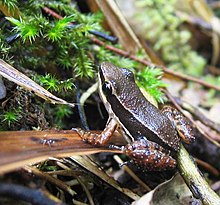Silverstoneia flotator
The rainforest rocket frog (Silverstoneia flotator) is a frog. It lives in Costa Rica and Panama. Scientists think it could live in Nicaragua too.[2][3][1]
| Silverstoneia flotator | |
|---|---|

| |
| Scientific classification | |
| Domain: | Eukaryota |
| Kingdom: | Animalia |
| Phylum: | Chordata |
| Class: | Amphibia |
| Order: | Anura |
| Family: | Dendrobatidae |
| Genus: | Silverstoneia |
| Species: | S. flotator
|
| Binomial name | |
| Silverstoneia flotator (Dunn, 1931)
| |
| Synonyms[2] | |
| |
Scientists are not sure that this is one species of frog. They think it might really be a few species.[1]
This frog lives on the ground in rainforests. This frog moves during the day. People have seen this frog between 10 and 865 meters above sea level. It lives near streams that have rocks in them. People have seen the frog in forests that have been cut down and are growing back.[1]
The female frog lays eggs in dead leaves on the ground. After the eggs hatch, the male frog carries the tadpoles streams.[1]
Scientists believe this frog is not in danger of dying out because it lives in a large place and it is good at living in places that human beings have changed. It is in some danger because human beings cut down forests to make farms, get wood to build with, and make towns.[1]
References
change- ↑ 1.0 1.1 1.2 1.3 1.4 1.5 IUCN SSC Amphibian Specialist Group (2015). "Rainforest Rocket Frog: Silverstoneia flotator". IUCN Red List of Threatened Species. 2015: e.T55082A54343502. doi:10.2305/IUCN.UK.2015-4.RLTS.T55082A54343502.en. Retrieved June 13, 2024.
- ↑ 2.0 2.1 Frost, Darrel R. "Silverstoneia flotator (Dunn, 1931)". Amphibian Species of the World, an Online Reference. Version 6.0. American Museum of Natural History, New York. Retrieved June 13, 2024.
- ↑ "Silverstoneia flotator (Dunn, 1931)". AmphibiaWeb. University of California, Berkeley. Retrieved June 13, 2024.
